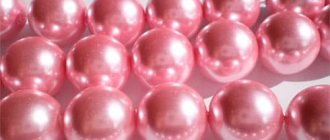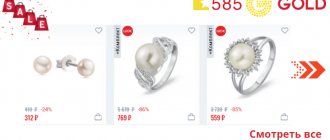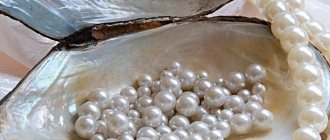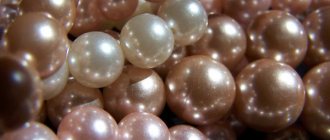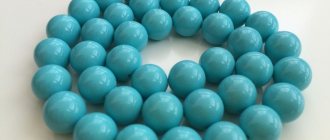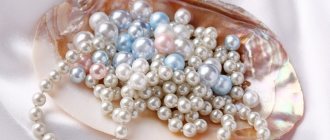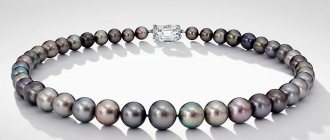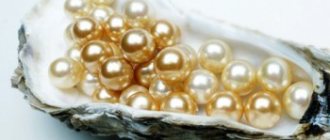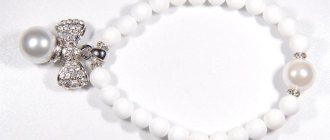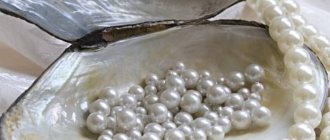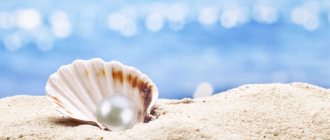Unlike minerals mined deep within the earth's crust, pearls are of organic origin. They mature in the shells of mollusks that live in the seas and northern fresh water bodies. How and where in the world are the most beautiful and highest quality pearls mined?
There are several natural places that we will talk about in the article.
How to get pearls
Pearls that are obtained from oysters living in the natural environment are called wild pearls. In order to find the right oyster, professional divers descend many meters under water, to places where there are large concentrations of mollusks.
A pearl does not appear in the shell from the very birth of the oyster, but only as it grows, if suddenly a foreign body - a tiny grain of sand - penetrates the animal’s belly. To protect the insides of its body, the oyster begins to envelop the stone with mother-of-pearl, thereby softening the sharp edges.
A mollusk can spend decades polishing, applying layer after layer, an established bead. It is these “pregnant” mollusks that fishermen hunt for. In one freshwater oyster you can find up to several beads, and in a sea oyster - up to 10.
Pearl mining occurs all over the world. But the scale of production of wild stone is inferior to that of cultivated stone.
View this post on Instagram
Post by Decoration • ????????? (@lina_bijouofficial) May 28, 2019 at 6:22 PDT
Pearl divers
Pearl divers are brave and strong-willed people, because when diving into the depths of the water for oysters, they risk being injured and sometimes even losing their lives. Gem hunters have developed physical muscles and large lung capacity to be able to dive to a depth of 50 meters and hold their breath for more than a minute.
Professional divers have been training their skills since childhood. Sea fishermen often look older than their years because salt water and sudden changes in pressure negatively affect their health. Previously, the mortality rate among swimmers was much higher due to the lack of necessary modern equipment for this profession.
During the dive process, a person must be especially careful. In sea and fresh waters, many dangers await him - from poisonous animals to predatory fish.
Previously, to protect themselves from bites, catchers wore linen suits and gloves, and lubricated exposed skin with special oil.
Japanese ama girls are famous all over the world. These are professional divers who use a unique breathing technique. It allows them to go without air for up to two minutes. Their training includes physical and mental preparation. Ama women pass on their secrets for extracting minerals from shells from generation to generation.
To continue the topic, watch the video:
Growth process
Loosely closed mollusk valves allow air, grains of sand, shell fragments or other small objects to enter.
When this happens, the oyster’s protective reaction, which nature has endowed it with, is triggered. The process of formation of a membrane begins around the foreign body. This is the growth of layers of nacre (the mother of pearls), which consists of aragonite, proteins and water. The growing shell covers the sharp edges of the embedded bodies so that their corners do not damage the oyster's body. The number of layers is in the hundreds and depends on the growth time. Pearls appear in a shell after 2-3 years, large specimens grow for 7-8 years.
The proteins occupy the spaces around the aragonite crystals, making the shell of the pearl strong. The top coating consists only of calcium carbonate, hence the pure pearlescent shine.
Pearl fishing in Russia
The first mention of pearl fishing in Russia occurs in the 10th–12th centuries; the peak of the fishery occurs in the 14th–15th centuries. The main practice was to extract the mineral from freshwater shells.
Russian pearls were famous for their unique shine and almost perfect spherical shape. But later, in the 17th century, during the reign of Peter, the mining of precious stones for private individuals was banned, which swept across the world like a wave. After this, special techniques for growing cultivated gems began to emerge.
Nowadays, cultured pearls occupy almost the entire market. But mining of the wild mineral was resumed, although not at all in the same volumes as before.
Today in Russia the origin of pearls is in water bodies:
- Karelia;
- Leningrad region;
- Novgorod region;
- Kola Peninsula.
Socotra Island and Gulf of Aden
They are famous for their rare pearls with a lead tint. Pearls are also obtained in the old way with the help of divers. Since the sea in these places is teeming with sharks, fishing is carried out only during the season when there are fewer of them. The swimmer's equipment consists of a diving weight and a basket for shells. To examine the bottom, use a special mirror, which represents a box with a glass bottom. The bottom of the sea is visible from the boat, and the swimmer descends behind the shells. In order not to breathe, a clothespin made of a cow's horn is put on the nose. This is a tribute to centuries-old traditions, since children inherit the work of their parents.
Fishing for sea pearls
The value of wild stone, compared to cultivated stone, is increased several times. This is due to the danger and ineffective extraction. Although it has a very small market share, it retains its position as one of the most expensive minerals. The most important points for finding sea oysters are:
- Red sea;
- Persian Gulf;
- the coast of Sri Lanka;
- shores of the Japanese islands;
- Indonesia;
- marine areas of Central America.
Depending on the deposit, minerals have their own distinctive qualities. In this regard, they are classified into:
- akoya sea pearls;
- South Sea pearls;
- Tahitian pearls.
Akoya pearl with gold insert
Black pearls of Tahiti
Southern Pearl
Different types of shellfish produce minerals of different shades.
For example, Black Sea oysters are characterized by small stones of gray-green or gray-violet colors. The most valuable bluish beads with a greenish tint are mined in Indonesia. The tridacnus species produces white and pink pearls, while the venus produces lavender pearls.
Islands of Bahrain and Qatar
High quality sea pearls of a soft pink hue are mined here. Divers extract shells from a depth of 15 meters. The only clothing is a loincloth; the nose is pinched with a bamboo clothespin. She collects the shells in a wire basket. An assistant remains in the boat and lifts the basket. If the team leaves for several days, then a singer goes with them, who entertains the catchers by singing songs. Hard work and prolonged exposure to salt water lead to exhaustion of the body and early death of pearl divers. For this reason, pearls are called “tears of the bay.” Production has decreased due to artificial methods of pearl cultivation and the discovery of oil production in the regions.
Fresh water production
Mining of the freshwater mineral mainly comes from:
- USA;
- Germany;
- England;
- China;
- some northern rivers of Russia.
Freshwater pearls are characterized by their small size and non-standard shape. It is dimmer than sea, but is particularly durable and reliable. The color palette is dominated by pink or grayish color with a matte pearlescent tint.
Production
Synthetic pearls are a product that is made by human hands. Such pearls have been in demand among the fair sex for several decades. The reason is that jewelry of this type is distinguished by its variety and affordable cost.
There are two types of artificial pearls in the world that are in greatest demand:
- Shell pearl.
- Majorica.
1) In the 15th-16th centuries, a technology was developed by which beads were coated with mother-of-pearl varnish. The technology has survived to this day. Any fashionista will be satisfied with the quality of such raw materials, and the Chanel jewelry house steadily uses this product.
In the process, they use a core that is cut from a mollusk shell. To prepare the coating, natural mother-of-pearl is taken, which is crushed to a powder and mixed with a special solution. The result is a large pearl measuring 10 mm or more, which shines and shimmers. It is smooth to the touch, unlike natural, which has a porous structure.
2) In second place are Majorica pearls, they are produced in Italy. Many people believe that technology has perfected industrial production. The process is simple: several layers of mother-of-pearl are applied to an alabaster ball.
The technology was honed on Spanish soil, on the island of Mallorca. The founder of the production of synthetic pearls was an emigrant from Germany, Eduard Hugo Hosch. His dream was to produce two hundred to perfection. It took no less than 120 years.
Today we can say with confidence that technology and craftsmanship have helped create pearls that are no different from natural ones, only slightly smaller and smoother.
Main advantages:
- Large size.
- Low cost.
- Rich palette of shades.
It is noteworthy that under artificial light, synthetic pearls sparkle and amaze with their intricate shades.
Today it is difficult to purchase a wild pearl as jewelry, since among all jewelry with pearls, only 2% is natural. Everything else is, to one degree or another, created by human hands. Cultured pearls are not much different from natural pearls, since they are created by man with the participation of a mollusk. Even an experienced jeweler will have difficulty distinguishing natural pearls from cultured ones, since visually they can be called identical.
Storage
It is best to store pearls in a cool, dark place, wrapped in a slightly damp cloth. This will help prevent dehydration and protect it from dust. Pearls should not be stored together with other precious stones, as the sharp edges of the crystals can scratch its surface. It is useful to rinse it in salty sea water from time to time.
It is advisable to wear pearl jewelry periodically so that it comes into contact with the skin. As you wear it, the top layers naturally exfoliate, which preserves its shine.
Properties ?
The pearl is covered with a layer of mother-of-pearl. This compound of calcium carbonate and protein is lighter and stronger than concrete.
Physico-chemical?
An unusual property is the layered structure. Organic and mineral plates alternate on the surface of the pearl. The layers do not touch. This arrangement gives rise to the iridescent glow of the pearl. Hence the pearlescent shine.
Pearls dissolve in the weakest acids.
Pearls have low hardness and cannot be ground or polished.
Are we being treated like in the old days?
The healing properties of pearls were described by ancient Arab healers and Avicenna in his famous “Canon of Medicine”.
Chinese Taoists considered shining balls an elixir that prolongs life.
The famous treatise of Tibetan medicine “Zhud-shi” states that pearls help with:
- nervous disorders;
- memory loss;
- nervous weakness.
Diseases treated with pearls:
- liver;
- kidney;
- Gastrointestinal tract;
- hypertension.
The opinions of modern lithotherapists coincide with the opinions of ancient healers.
Expert opinion
Semenishcheva Polina
Specialist in mineralogy. Graduated from St. Petersburg Mining University.
Important : changes in the composition of sweat due to illness of the owner can reduce the shine of the pearl. If your pearl necklace has faded, the shine of the stone has disappeared - do not be lazy, go to the doctor, get tested.
Pearl water?
Leave a few pearls (natural or cultured) in a glass of clean water overnight. Don't expect any benefit from the artificial.
Drink water in the morning (don’t swallow the pearls!
